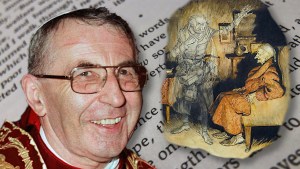Pope John Paul I did not write much during his short pontificate, but he was quite active in the years before his death as the Patriarch of Venice.
A collection of letters was later published as Illustrissimi (To the Illustrious Ones). The letters were written between 1971 and 1975 for the Catholic newspaper Messaggero di S. Antonio.
In addition to writing to Charles Dickens, he also wrote to Samuel Clemens, better known as Mark Twain.
One of his favorite authors
John Paul I starts off his letter praising Mark Twain and his favorite stories:
When I was a boy, you were one of my favorite writes. I still remember The Adventures of Tom Sawyer, which were the adventures of your own childhood. Some of your stories I’ve told people a hundred times–the one about the value of books, for instance.
What’s interesting is how he thought his affection for Mark Twain’s writings would upset a few people, as he continues in his letter, “I’m afraid people in my diocese are going to be shocked. ‘A bishop quoting Mark Twain!’ they’ll say.”
The Three Johns
The bulk of his letter reflects on a quotation from Mark Twain about Three Johns:
I shall…recall that you once said: “Man is more complex than he seems. Every adult has in him not one but three distinct men.” “How is that?” you were asked. “Well, take any man called John. In him there’s John the First, that is, the man he thinks he is; there’s John the Second, the man others think he is; and finally there’s John the Third. the man he really is.”
John Paul I continues by saying, “there’s a great deal of truth in that story of yours, dear Twain.”
For example, he explains how John the First emphasizes our vanity:
When we’re shown a group photograph in which we’ve appeared, which is the nice pleasant face we first look for? I hate to say it, but it’s our own. Because we like ourselves enormously, we prefer ourselves to other people.
John the Second follows in a similar fashion, wanting others to see us in a positive light, upset when people do not admire us.
The final “John,” is meant to be the “one whom God likes,” the one who does the will of God.
He concludes the letter appealing to the people of his diocese to choose this last John:
I urge my faithful: If you happen to think again of the three Johns…that are in each of us, pay special attention to the third, the one whom God likes!


